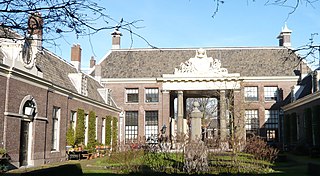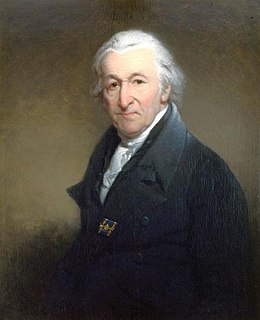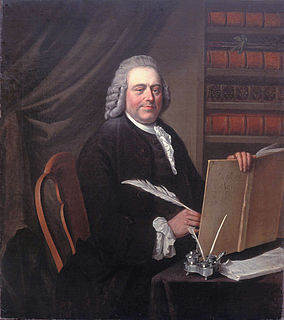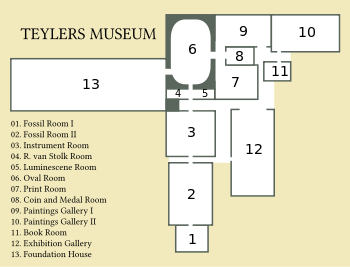
The Frans Hals Museum is a museum located in Haarlem, the Netherlands.

Teylers Museum is an art, natural history, and science museum in Haarlem, Netherlands. Established in 1778, Teylers Museum was founded as a centre for contemporary art and science. The historic centre of the museum is the neoclassical Oval Room (1784), which was built behind the house of Pieter Teyler van der Hulst (1702–1778), the so-called Fundatiehuis. Pieter Teyler was a wealthy cloth merchant and banker of Scottish descent, who bequeathed his fortune for the advancement of religion, art, and science. He was a Mennonite and follower of the Scottish Enlightenment.

The Teylershofje is a hofje in Haarlem, Netherlands with 24 houses.

Martin(us) van Marum was a Dutch physician, inventor, scientist and teacher, who studied medicine and philosophy in Groningen. Van Marum introduced modern chemistry in the Netherlands after the theories of Lavoisier, and several scientific applications for general use. He became famous for his demonstrations with instruments, most notable the Large electricity machine, to show statical electricity and chemical experiments while curator for the Teylers Museum.

Pieter Teyler van der Hulst was a wealthy Dutch Mennonite merchant and banker, who died childless, leaving a legacy of two million florins to the pursuit of religion, arts and science in his hometown, that led to the formation of Teyler's Museum. This was not the value of his entire estate. He also founded Teylers Hofje in his name, and made important donations to individuals in the Mennonite community.

Tiberius Cornelis Winkler was a Dutch anatomist, zoologist and natural historian, and the second curator of geology, paleontology and mineralogy at Teylers Museum in Haarlem. Besides translating the first edition of Charles Darwin's Origin of Species (1860), he wrote a great number of works popularising science, particularly the life sciences.

Wybrand Hendriks was a Dutch painter, primarily known for his portraits, and the concierge of the Teylers Museum.

Hendrik Jacobus Scholten, was a 19th-century painter from the Netherlands.

The Fundatiehuis is the former family home of Pieter Teyler van der Hulst on the Damstraat 21 in Haarlem, Netherlands. After his death it became the seat of the Teylers Stichting and through its front door, visitors could reach the Oval room.

Leendert Viervant de Jonge, was a Dutch architect and cabinet builder.

Jacobus Barnaart was a Dutch merchant and one of the five first directors of the Teylers Stichting.

The Teylers astronomical observatory is an astronomical observatory built in 1784 on the roof of the Oval Room of the Teylers Museum in Haarlem.

Cornelis van Noorde, was an 18th-century landscape painter and draughtsman from the Northern Netherlands.

Volkert Simon Maarten van der Willigen, sometimes referred to as Volcardus Simon Martinus van der Willigen, was a Dutch mathematician, physicist and professor.

John Cuthbertson was an English instrument maker and inventor that lived from 1768 until roughly 1796 in Amsterdam.

The Eerste Schilderijenzaal, or Painting Gallery I, is one of two art gallery rooms in Teylers Museum and is the oldest art gallery for contemporary Dutch art in the Netherlands. It was built onto the back of Teylers Oval Room in 1838. It was the young museum's first exhibition space for paintings and could be entered through the Oval Room, which was itself located behind the Fundatiehuis, the former home of Pieter Teyler van der Hulst.

The Tweede Schilderijenzaal, or Painting Gallery II, is one of two art gallery rooms in Teylers Museum. The Tweede Schilderijenzaal was built in 1893 as an extension of the first gallery.

The Instrument Room is a room in Teylers Museum which houses a part of the museum's Cabinet of Physics: a collection of scientific instruments from the 18th and 19th centuries. The instruments in the collection were used for research as well as for educational public demonstrations. Most of them are demonstration models that illustrate various aspects of electricity, acoustics, light, magnetism, thermodynamics, and weights and measures. The rest are high-quality precision instruments that were used for research.

The large electrostatic generator is a large handcrafted electromechanical instrument designed by Martin van Marum and built by John Cuthbertson in 1784 for the Teylers Museum in Haarlem, where it forms the centerpiece of the instrument room. The concept of an electrostatic generator was new, and the battery (array) of leiden jars was the largest ever built. The two glass disks of the generator are 1.65 meters in diameter, and the machine is capable of generating a potential of 330,000 volts.

The Teylers Coin and Medal Room, or Numismatisch Kabinet, is a small display room in Teylers Museum that was designed in 1888 and furnished with special display cabinets in 1889.






















